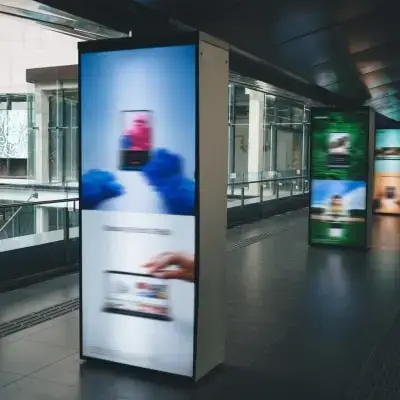Industry Statistics and Trends
Market size and recent performance (2015-2030)
Industry revenue has declined at a CAGR of 5.0 % over the past five years, to reach an estimated €4.3bn in 2025.
Trends and Insights
The declining production figures in the automotive industry had a negative impact on the sector
- The lamp and lighting manufacturing industry is closely intertwined with the German automotive industry. According to current IBISWorld estimates, just under a third of industry revenue is generated through the sale of headlights, rear lights and interior lighting solutions to vehicle manufacturers. The automotive sector is therefore the most important sales market for manufacturers of lamps and lights. According to the German Association of the Automotive Industry, car production in Germany fell from around 4.7 million in 2019 to around 4.1 million vehicles in 2024.
- Additional trends and insights available with purchase
Industry outlook (2025-2030)
Market size is projected to decline over the next five years.
Trends and Insights
Innovative laser headlights offer German lamp manufacturers new market opportunities
- The development of laser spotlights marks a significant innovation boost in the manufacture of lamps and luminaires. This technology is based on laser diodes whose light is converted into intense white light by a phosphor layer. Compared to conventional LED or halogen solutions, laser headlights offer higher luminous intensity, increased energy efficiency and a longer service life. They are therefore considered a promising further development for applications with high performance requirements, particularly in the automotive and high-end electronics sectors.
Biggest companies in the Electric Lighting Equipment Manufacturing in Germany
| Company | Market Share (%)
2025 | Revenue (€m)
2025 |
|---|---|---|
Ams-Osram AG | 914.0 | |
Marelli Automotive Lighting Reutlingen (Germany) GmbH | 779.2 | |
Ledvance GmbH | 551.0 |
To view the market share and analysis for all 7 top companies in this industry, view purchase options.
Products & Services Segmentation
Industry revenue is measured across several distinct product and services lines, including Ceiling and wall lighting, Headlights and Electrical lighting fixtures made of plastic and other materials. Ceiling and wall lighting is the largest segment of the Electric Lighting Equipment Manufacturing in Germany.
Trends and Insights
Competitive pressure from foreign manufacturers leads to declining sales of ceiling and wall lighting
- Ceiling and wall lights are products that are mounted on the ceiling or wall to illuminate the room and create an aesthetic lighting design.
- More insights available in the full report
Table of Contents
About this industry
Industry definition
The industry specialises in the manufacture of light bulbs, light fittings and parts thereof. Its products also include lighting fixtures and parts thereof. However, its activities do not include the manufacture of glass blanks for light bulbs and other glassware required as parts for lamps and luminaires, as well as electrical installation material for lighting fixtures.
What's included in this industry?
Products and services covered in the Electric Lighting Equipment Manufacturing industry in Germany include Ceiling and wall lighting, Headlights, Electrical lighting fixtures made of plastic and other materials, Halogen lamps, Illuminated signs and Parts of lamps and lights.Companies
Companies covered in the Electric Lighting Equipment Manufacturing industry in Germany include Ams-Osram AG, Marelli Automotive Lighting Reutlingen (Germany) GmbH and Ledvance GmbH.Purchase this report to view all 7 major companies in this industry.
Related Terms
Related terms covered in the Electric Lighting Equipment Manufacturing industry in Germany include energy efficiency class, halog lamp, human centric lighting, artificial intelligence (ki), lamp, light and organic light-emitting diode (oled).Industry Code
WZ 27.40 - Electric Lighting Equipment Manufacturing in Germany
Performance
Get an indication of the industry's health through historical, current and forward-looking trends in the performance indicators that make or break businesses.
Analyst insights
The manufacturers of lamps and luminaires are heavily dependent on the automotive industry, as a significant proportion of their sales are generated through vehicle lighting. ...
In this chapter (4)
- Current Performance
- Outlook
- Volatility
- Life Cycle
Key metrics
- Annual Revenue, Recent Growth, Forecast, Revenue Volatility
- Number of Employees, Recent Growth, Forecast, Employees per Business, Revenue per Employee
- Number of Businesses, Recent Growth, Forecast, Employees per Business, Revenue per Business
- Total Profit, Profit Margin, Profit per Business
Charts
- Revenue, including historical (2015-2024) and forecast (2025-2030)
- Employees, including historical (2015-2024) and forecast (2025-2030)
- Businesses, including historical (2015-2024) and forecast (2025-2030)
- Profit, including historical (2015-2025)
- Industry Volatility vs. Revenue Growth
- Industry Life Cycle
Detailed analysis
- Trends in supply, demand and current events that are driving current industry performance
- Expected trends, economic factors and ongoing events that drive the industry's outlook
- Key success factors for businesses to overcome volatility
- How contribution to GDP, industry saturation, innovation, consolidation, and technology and systems influence the industry's life cycle phase.
Products and Markets
Learn about an industry's products and services, markets and trends in international trade.
Analyst insight
The basic tariffs of 10% announced by the USA on imports from the EU, including electric lamps and luminaires, will significantly restrict the export opportunities of German m...
In this chapter
- Products & Services
- Major Markets
- International Trade
Key metrics
- Largest market segment and value in 2025
- Product innovation level
- Total imports, level and trend
- Total exports, level and trend
- Trade Balance
Charts
- Products & services segmentation in 2025
- Major market segmentation in 2025
- International trade, including imports by country and exports by country
Detailed analysis
- Trends impacting the recent performance of the industry's various segments
- Innovations in the industry's product or service offering, specialization or delivery method
- Key factors that successful businesses consider in their offerings
- Buying segments and key trends influencing demand for industry products and services
- Recent trends in import and export volumes, country of origin or destination, and expected future trends
Geographic Breakdown
Discover where business activity is most concentrated in an industry and the factors driving these trends to find opportunities and conduct regional benchmarking.
Analyst insights
The centre of Germany is home to the largest number of companies in the industry. The region is characterised by the presence of numerous suppliers and the excellent transpor...
In this chapter (1)
- Business Locations
Charts
- Share of revenue, establishment, wages and employment in each region
- Share of population compared to establishments in each region in 2025
Tables
- Number and share of establishments in each region in 2025
- Number and share of revenue each region accounts for in 2025
- Number and share of wages each region accounts for in 2025
- Number and share of employees in each region in 2025
Detailed analysis
- Geographic spread of the industry across Europe, and trends associated with changes in the business landscape
- Key success factors for businesses to use location to their advantage
Competitive Forces
Get data and insights on what's driving competition in an industry and the challenges industry operators and new entrants may face, with analysis built around Porter's Five Forces framework.
Analyst insights
The individual market segments are dominated by a few manufacturers. The companies in the industry are not usually in direct competition with each other due to their differen...
In this chapter (4)
- Concentration
- Barriers to Entry
- Substitutes
- Buyer & Supplier Analysis
Key metrics
- Industry concentration level
- Industry competition level and trend
- Barriers to entry level and trend
- Substitutes level and trend
- Buyer power level and trend
- Supplier power level and trend
Charts
- Market share concentration among the top 4 suppliers from 2020-2025
- Supply chain including upstream supplying industries and downstream buying industries, flow chart
Detailed analysis
- Factors impacting the industry’s level of concentration, such as business distribution, new entrants, or merger and acquisition activity.
- Key success factors for businesses to manage the competitive environment of the industry.
- Challenges that potential industry entrants face such as legal, start-up costs, differentiation, labor/capital intensity and capital expenses.
- Key success factors for potential entrants to overcome barriers to entry.
- Competitive threats from potential substitutes for the industry’s own products and services.
- Key success factors for how successful businesses can compete with substitutes.
- Advantages that buyers have to keep favorable purchasing conditions.
- Advantages that suppliers have to maintain favorable selling conditions.
- Key success factors for how businesses can navigate buyer and supplier power.
Companies
Learn about the performance of the top companies in the industry.
Analyst insights
Market leader Marelli supplies the automotive industry with lighting technology. In recent years, the company has launched innovative matrix LED headlights onto the market.
In this chapter
- Market Share Concentration
- Companies
- Company Spotlights
Charts
- Industry market share by company in 2021 through 2025
- Major companies in the industry, including market share, revenue, profit and profit margin in 2025
- Overview of Ams-Osram AG's performance by revenue, market share and profit margin from 2019 through 2025
- Overview of Marelli Automotive Lighting Reutlingen (Germany) GmbH's performance by revenue, market share and profit margin from 2019 through 2025
- Overview of Ledvance GmbH's performance by revenue, market share and profit margin from 2019 through 2025
- Overview of revenue, market share and profit margin trend for 4 additional companies
Detailed analysis
- Description and key data for Ams-Osram AG, and factors influencing its performance in the industry
- Description and key data for Marelli Automotive Lighting Reutlingen (Germany) GmbH, and factors influencing its performance in the industry
- Description and key data for Ledvance GmbH, and factors influencing its performance in the industry
- Description, key data and performance trends for 4 additional companies
External Environment
Understand the demographic, economic and regulatory factors that shape how businesses in an industry perform.
Analyst insights
Halogen lamps were essentially excluded from the market by the Ecodesign Directive. From September 2021, compact fluorescent lamps with integrated ballasts may no longer be p...
In this chapter
- External Drivers
- Regulation & Policy
- Assistance
Key metrics
- Regulation & policy level and trend
- Assistance level and trend
Charts
- Regulation & Policy historical data and forecast (2015-2030)
- Assistance historical data and forecast (2015-2030)
Detailed analysis
- Demographic and macroeconomic factors influencing the industry, including Regulation & Policy and Assistance
- Major types of regulations, regulatory bodies, industry standards or specific regulations impacting requirements for industry operators
- Key governmental and non-governmental groups or policies that may provide some relief for industry operators.
Financial Benchmarks
View average costs for industry operators and compare financial data against an industry's financial benchmarks over time.
Analyst insights
The companies in the sector have recently been able to expand their profit margins. The main reasons for this were the high demand for more expensive LED products and the dev...
In this chapter
- Cost Structure
- Financial Ratios
- Key Ratios
Key metrics
- Profit margin, and how it compares to the sector-wide margin
- Average wages, and how it compares to the sector-wide average wage
- Largest cost component as a percentage of revenue
- Industry average ratios for days' receivables, industry coverage and debt-to-net-worth ratio
Charts
- Average industry operating costs as a share of revenue, including purchases, wages, depreciation, utilities, rent, other costs and profit in 2025
- Average sector operating costs as a share of revenue, including purchases, wages, depreciation, utilities, rent, other costs and profit in 2025
- Investment vs. share of economy
Data tables
- Cash Flow & Debt Service Ratios (2015-2030)
- Revenue per Employee (2015-2030)
- Revenue per Enterprise (2015-2030)
- Employees per Establishment (2015-2030)
- Employees per Enterprise (2015-2030)
- Average Wage (2015-2030)
- Wages/Revenue (2015-2030)
- Establishments per Enterprise (2015-2030)
- IVA/Revenue (2015-2030)
- Imports/Demand (2015-2030)
- Exports/Revenue (2015-2030)
Detailed analysis
- Trends in the cost component for industry operators and their impact on industry costs and profitability
Key Statistics
Industry Data
Data Tables
Including values and annual change:
- Revenue (2015-2030)
- IVA (2015-2030)
- Establishments (2015-2030)
- Enterprises (2015-2030)
- Employment (2015-2030)
- Exports (2015-2030)
- Imports (2015-2030)
- Wages (2015-2030)
Top Questions Answered
Unlock comprehensive answers and precise data upon purchase. View purchase options.
What is the market size of the Electric Lighting Equipment Manufacturing industry in Germany in 2025?
The market size of the Electric Lighting Equipment Manufacturing industry in Germany is €4.3bn in 2025.
How many businesses are there in the Electric Lighting Equipment Manufacturing industry in Germany in 2025?
There are 191 businesses in the Electric Lighting Equipment Manufacturing industry in Germany, which has declined at a CAGR of 0.6 % between 2020 and 2025.
How may import tariffs affect the Electric Lighting Equipment Manufacturing industry in Germany?
The Electric Lighting Equipment Manufacturing industry in Germany is likely to be significantly impacted by import tariffs with imports accounting for a high share of industry revenue.
How may export tariffs affect the Electric Lighting Equipment Manufacturing industry in Germany?
The Electric Lighting Equipment Manufacturing industry in Germany is likely to be significantly impacted by export tariffs with exports accounting for a high share of industry revenue.
Has the Electric Lighting Equipment Manufacturing industry in Germany grown or declined over the past 5 years?
The market size of the Electric Lighting Equipment Manufacturing industry in Germany has been declining at a CAGR of 5.0 % between 2020 and 2025.
What is the forecast growth of the Electric Lighting Equipment Manufacturing industry in Germany over the next 5 years?
Over the next five years, the Electric Lighting Equipment Manufacturing industry in Germany is expected to decline.
What are the biggest companies in the Electric Lighting Equipment Manufacturing industry in Germany?
The biggest companies operating in the Electric Lighting Equipment Manufacturing industry in Germany are Ams-Osram AG, Marelli Automotive Lighting Reutlingen (Germany) GmbH and Ledvance GmbH
What does the Electric Lighting Equipment Manufacturing industry in Germany include?
Ceiling and wall lighting and Headlights are part of the Electric Lighting Equipment Manufacturing industry in Germany.
Which companies have the highest market share in the Electric Lighting Equipment Manufacturing industry in Germany?
The company holding the most market share in the Electric Lighting Equipment Manufacturing industry in Germany is Ams-Osram AG.
How competitive is the Electric Lighting Equipment Manufacturing industry in Germany?
The level of competition is high and steady in the Electric Lighting Equipment Manufacturing industry in Germany.
Methodology
How are IBISWorld reports created?
IBISWorld has been a leading provider of trusted industry research for over 50 years to the most successful companies worldwide. With offices in Australia, the United States, the United Kingdom, Germany and China, we are proud to have local teams of analysts that conduct research, data analysis and forecasting to produce data-driven industry reports.
Our analysts start with official, verified and publicly available sources of data to build the most accurate picture of each industry. Analysts then leverage their expertise and knowledge of the local markets to synthesize trends into digestible content for IBISWorld readers. Finally, each report is reviewed by one of IBISWorld’s editors, who provide quality assurance to ensure accuracy and readability.
IBISWorld relies on human-verified data and human-written analysis to compile each standard industry report. We do not use generative AI tools to write insights, although members can choose to leverage AI-based tools within the platform to generate additional analysis formats.
What data sources do IBISWorld analysts use?
Each industry report incorporates data and research from government databases, industry-specific sources, industry contacts, and our own proprietary database of statistics and analysis to provide balanced, independent and accurate insights.
Key data sources in Germany include:
- German Federal Statistics Office (Destatis)
- European Statistics Office (Eurostat)
- United Nations Comtrade
Analysts also use industry specific sources to complement catch-all sources, although their perspective may focus on a particular organization or representative body, rather than a clear overview of all industry operations. However, when balanced against other perspectives, industry-specific sources provide insights into industry trends.
These sources include:
- Industry and trade associations
- Industry federations or regulators
- Major industry players annual or quarterly filings
Finally, IBISWorld’s global data scientists maintain a proprietary database of macroeconomic and demand drivers, which our analysts use to help inform industry data and trends. They also maintain a database of statistics and analysis on thousands of industries, which has been built over our more than 50-year history and offers comprehensive insights into long-term trends.
How does IBISWorld forecast its data?
IBISWorld’s analysts and data scientists use the sources above to create forecasts for our proprietary datasets and industry statistics. Depending on the dataset, they may use regression analysis, multivariate analysis, time-series analysis or exponential smoothing techniques to project future data for the industry or driver. Additionally, analysts will leverage their local knowledge of industry operating and regulatory conditions to impart their best judgment on the forecast model.
IBISWorld prides itself on being a trusted, independent source of data, with over 50 years of experience building and maintaining rich datasets and forecasting tools. We are proud to be the keystone source of industry information for thousands of companies across the world.
Learn more about our methodology and data sourcing on the Help Center.










